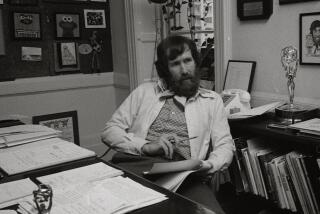Kermit’s big leap back toward the green
- Share via
A quarter-century ago, Kermit the Frog was one of the most beloved characters in family entertainment, a sweet-tempered, banjo-picking amphibian who sang of racial tolerance and undying dreams in tunes like “It’s Not Easy Bein’ Green” and the Oscar-nominated “The Rainbow Connection.”
These days, though, the frog has to jump to make a buck -- and get attention. On Sunday, Kermit and his longtime love interest, Miss Piggy, will star in two new ads pitching cars and pizza during ABC’s Super Bowl XL. Walt Disney Co., which acquired the rights to Kermit and other non-”Sesame Street” Muppet characters for a reported $60 million in 2004, hopes the spots will spark a revival of the franchise, which faded after the 1990 death of creator Jim Henson.
As with many Hollywood comebacks, the saga of how Kermit is trying to leap back on top is a story of changing tastes and the eternal quest for green.
The executive in charge of the Muppets says the studio envisions Kermit and Miss Piggy as “evergreen” characters, akin to Mickey Mouse and Winnie the Pooh. Every division at the company is contributing ideas to the renewal project. Among the proposals under consideration: a mock reality TV series and a Broadway musical a la “The Lion King.”
Kermit “has been resting on his reputation from the TV show of the late ‘70s,” said Disney Executive Vice President Russell Hampton, referring to “The Muppet Show,” which had an extraordinarily successful syndicated run from 1976 to 1981.
The Super Bowl spots -- Kermit will plug the Ford Escape SUV, while Miss Piggy will dance with Jessica Simpson to shill for Pizza Hut (a larger Muppet crew appeared in the food chain’s ad last year) -- are guaranteed to put the characters before a large audience again, Hampton noted.
But some skeptics wonder whether even a studio as vast and deep-pocketed as Disney can rekindle the Muppet magic.
Kermit was so popular during his heyday that he once subbed for Johnny Carson on NBC’s “The Tonight Show.” But while the talking frog remains a nostalgic touchstone for aging boomers, executives admit that most kids today recognize him only vaguely, if at all. Over the past decade, theatrical movies and TV shows featuring the characters have received scant notice, with some viewing the Muppets’ gentle, unassuming humor as hopelessly out of step with the times. And Disney’s pending $7.4-billion purchase of “Toy Story” producer Pixar Animation Studios may heighten the company’s focus on newer, computer-generated characters.
“It’s sad to see them doing pizza commercials,” said Bernie Brillstein, a veteran Hollywood manager who guided Henson’s career for 30 years. But “I think [Disney] will have a very difficult time bringing them up to date. They define a time and a special place ... there are things that don’t work anymore.”
Director Frank Oz, Henson’s longtime creative partner as well as the original Miss Piggy, feels Disney is sincere about wanting to recharge the Muppets but remains dubious about the studio’s efforts so far. “The way they’re going about it, they don’t understand it’s going to take more than organization. “You’re trying to take a mom-and-pop organization and re-create it through a corporation.”
Kermit’s fate shows how relatively quickly even a world-famous brand can ebb without constant upkeep. Since Henson’s unexpected death at age 53, corporate control of Kermit and Miss Piggy has changed hands three times. Even today, Disney doesn’t own the rights to all the characters that sprang from Henson’s shop; Big Bird, Bert and Ernie, Elmo and other icons of the preschool set belong to the nonprofit Sesame Workshop, producer of PBS’ “Sesame Street.”
Perhaps more important, the decline of the Muppets offers an instructive lesson in the vagaries of the market for family entertainment. Nickelodeon, Cartoon Network, Disney Channel and others are vying for children’s attention, constantly churning out a panoply of new characters for every age range and taste. While the latest generation of kids tuned in to Dora the Explorer and SpongeBob SquarePants, the Muppets fossilized, as much a cultural artifact as mood rings or vinyl records.
“There was a certain creative malaise, post-Jim Henson,” said Martin Brochstein, editorial director of EPM Communications, which publishes newsletters on product licensing and other marketing issues.
It all began ...
In a sense, such malaise was understandable, given Henson’s acclaimed gifts as creative overseer. He first introduced Kermit in 1955 on “Sam & Friends,” a kids’ show that ran in Washington, D.C. A few years later, the young puppeteer showed up at the William Morris Agency in New York. Initially skeptical, Brillstein, then a young agent, watched Henson do a bit with a two-headed cow puppet and decided to sign him on the spot.
The Muppets’ popularity slowly grew with commercials and TV guest spots during the 1960s. But they shot to national fame in 1969 with the premiere of “Sesame Street,” a milestone in educational TV. Henson characters such as Grover, Cookie Monster and Count von Count established an instant rapport with young children learning basic language and math concepts. Meanwhile, Kermit’s rendition of “Bein’ Green” (Henson himself operated and voiced the character) drew wide praise as a plea for racial understanding in an educational system that was still grappling with desegregation.
By the end of the 1970s, the Muppets reached the apex of their fame. Over five seasons in syndication, “The Muppet Show” drew an eclectic mix of celebrity guests, and their first feature, 1979’s “The Muppet Movie,” grossed more than $76 million in domestic box office.
Henson began to branch out with non-Muppet fantasies and sci-fi fare. But in 1990, just days before Disney was to buy his company for a reported $150 million, he died of complications from pneumonia. In the wake of his death, the Disney deal was scotched -- and Kermit and Miss Piggy fell into more than a decade of creative and commercial limbo.
Brian and Lisa Henson, the puppeteer’s adult children, sold the Jim Henson Co. in 2000 to a German firm, EM.TV & Merchandising, for a reported $680 million. But the company quickly ran into financial trouble and was forced to put the Muppets back on the block. Sesame Workshop, which had been paying Henson’s company a license fee of up to $20 million annually to use Elmo and other Muppets, leaped in to buy the characters from EM.TV for $180 million.
Bought and sold
That meant that the remaining characters, including Kermit and Miss Piggy, were on their own -- which critics like Brillstein say has diluted their value. The Henson children repurchased the remnants of their father’s company in 2003 and then sold Kermit and other “classic Muppet” characters to Disney, whose then-chief, Michael Eisner, had remained a big fan. (Through representatives, Brian and Lisa Henson and Eisner declined to comment.)
The Henson Co. still actively produces (recent projects have included Sci-Fi Channel’s “Farscape”) and retains the rights to “Fraggle Rock” and other properties.
So far, Disney has little to show for its investment. In May, the studio’s ABC network tanked in the ratings with “The Muppets’ Wizard of Oz,” a TV movie starring Kermit, Miss Piggy and the rest of Henson’s distinctive crew. At least two proposed TV series starring the Muppet gang have yet to appear. The feature film and Broadway show are tied up in development; Disney’s Hampton characterized them only as “ideas.”
Brochstein said that the Super Bowl ads may help remind viewers of what they loved about the Muppets. But the commercials won’t be nearly enough to restore Kermit and Miss Piggy to their former luster. “It’s a matter of re-injecting the characters into the culture with high-quality content that people relate to,” he said. “It sounds like a simple thing, but it ain’t.”
Disney’s Hampton, for his part, said the studio is not about to give up. “We recognize we have a job in front of us,” he said. “But we’re going to take the time to do it right.”
More to Read
The biggest entertainment stories
Get our big stories about Hollywood, film, television, music, arts, culture and more right in your inbox as soon as they publish.
You may occasionally receive promotional content from the Los Angeles Times.











